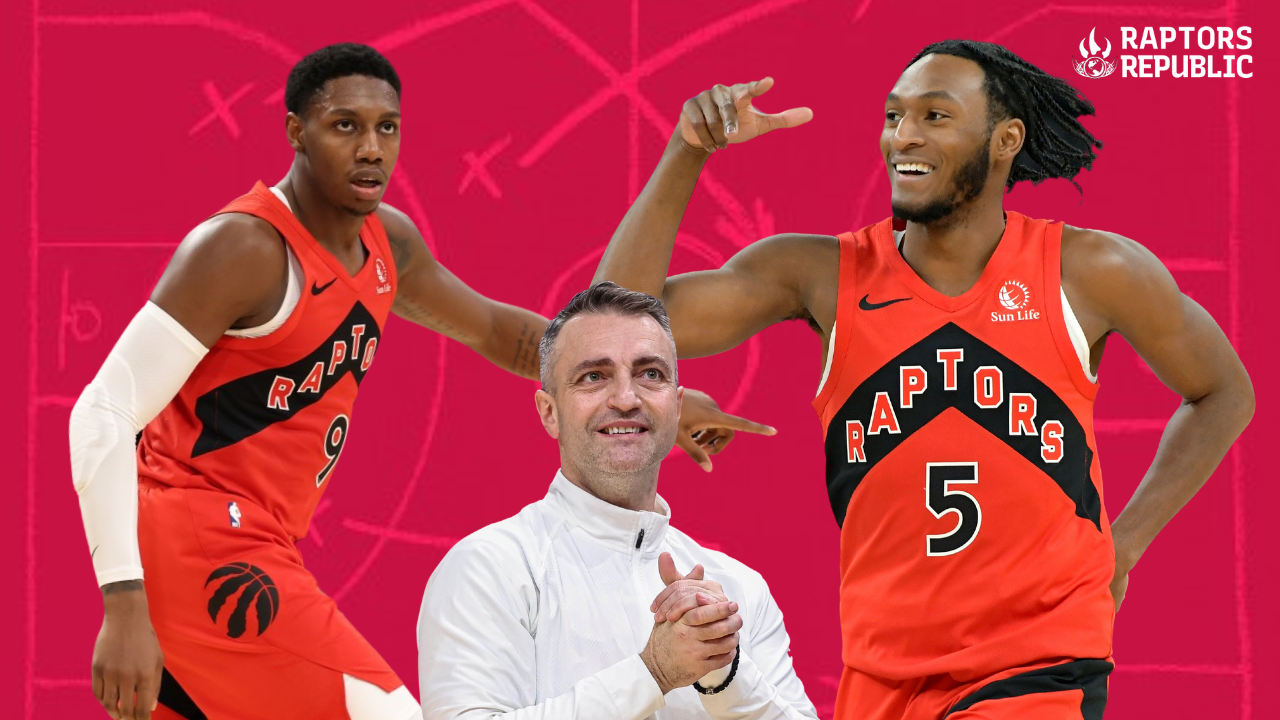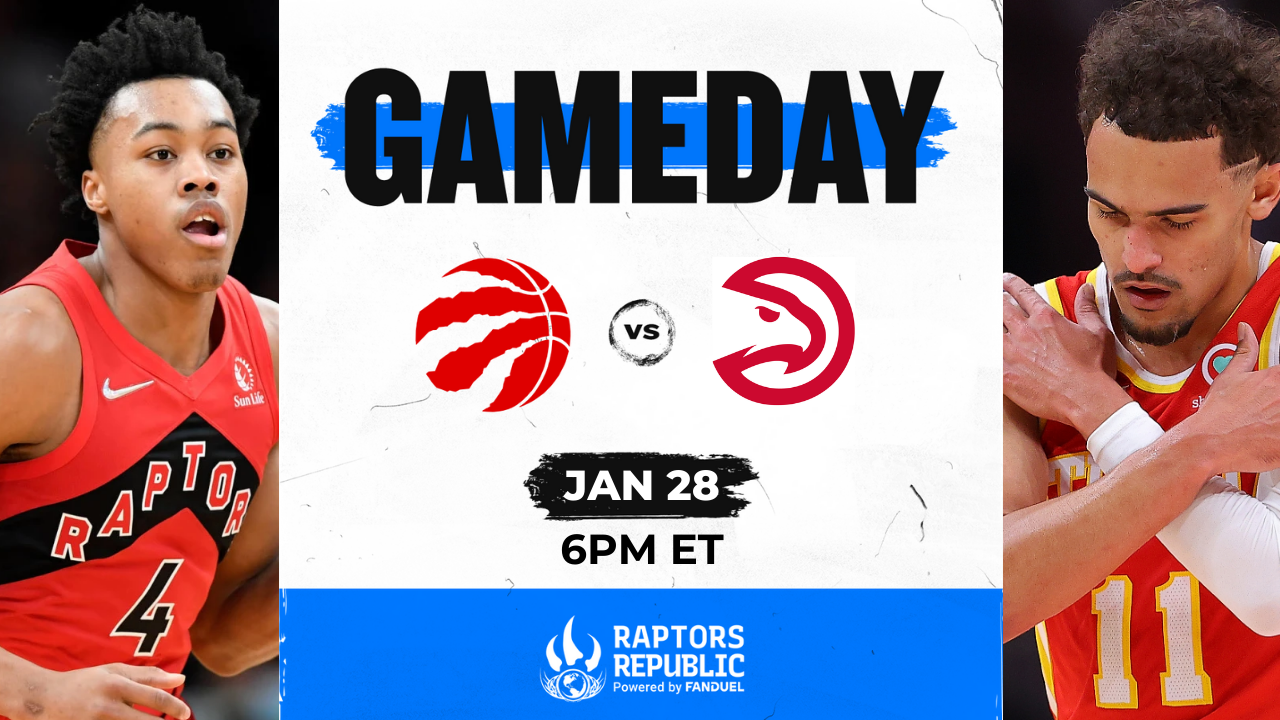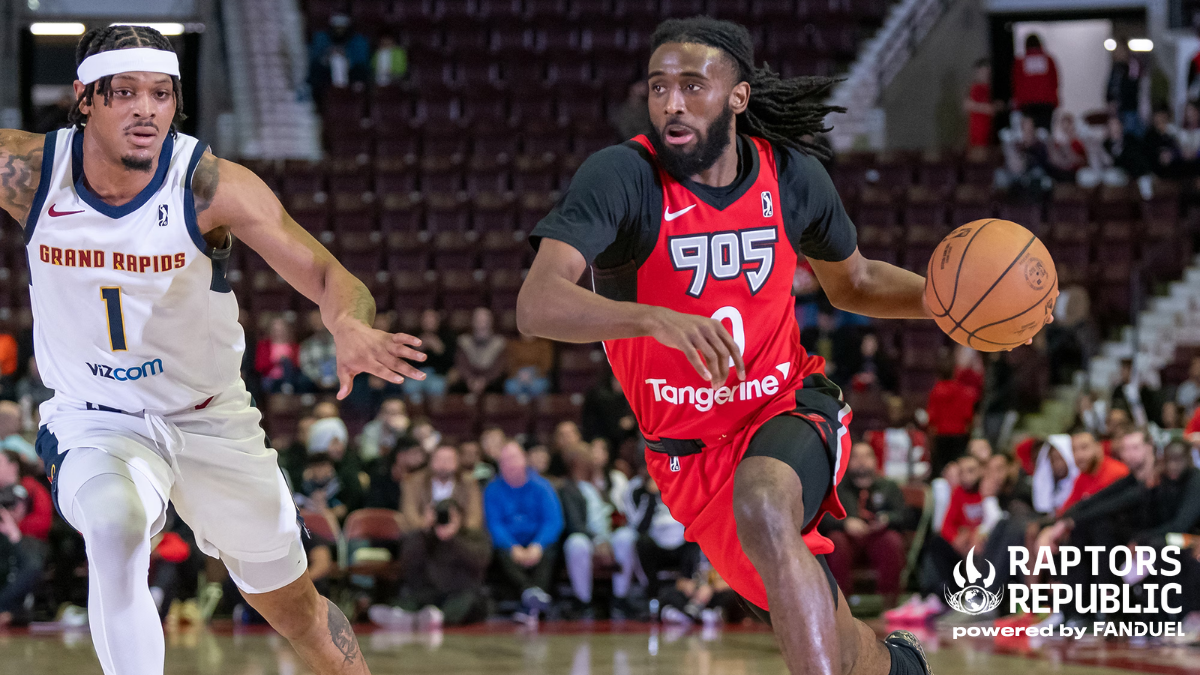If you hadn’t watched much of the NBA for the past four or five years, outside of the Toronto Raptors, you might think Scottie Barnes was the best and most exciting prospect in the league. Maybe in history. He slams dunks over bigs and smalls alike, splashes triples. He swats shots like prime LeBron James and picks off passes with his enormous length. He is one of the best and most productive passers in league history. And he’s doing it all at just 22 years old.
There have only been 61 seasons in which players have averaged 20 points, 8 rebounds, 5 assists, 1 steal, and 1 block per game. (And those 61 seasons have only been accomplished by 24 players — Larry Bird has the most seasons, with nine to his name.) But Barnes is the fourth-youngest player to ever do it.
The thing is, two of the other three (Luka Doncic and Alperen Sengun) have done it quite recently or are in the midst of doing it this year. Magic Johnson is the only historical comp. Young players are just putting up more numbers now than they ever have. So zoom out, and you’ll see that Barnes certainly is one of the best and most exciting young prospects in the league. But he’s not clearly the best in the league, as one might think.
Comparison is the thief of joy, yes. But the NBA is a zero-sum environment that necessitates comparison. So where does that leave the Raptors? At the very least, having a little fun with rankings every now and then. How do Barnes and the rest of the young core in Toronto compare to the remainder of the NBA when it comes to teams that are positioned to contend in the future?
First, some definitions. Obviously. The best part. So let’s cap this at 24 years old. Why 24? I don’t know. Random. It feels young. (And it includes Toronto’s best players, so.) We’re going to start with the Raptors, then look at some of the other best young cores in the league. Let’s sort by current production and chances at becoming a star, whatever that means.
Toronto’s young core
Scottie Barnes: Obviously the crown jewel is Barnes himself. He ranks seventh in win shares among players 24 or under. EPM has him a little lower, but still in the top 10. As said above, he does everything. His jumper is trending downward a little bit, but he’s still gone a long way to establishing a reputation as a shooter this year. He’s drawing longer closeouts, which is giving him opener driving lanes.
The passing is the superpower. He throws some of the most advantage-creating passes in the league. Perhaps he’s top-five already, and I’m guessing there, but there’s really no one other than Trae Young, Tyrese Haliburton, Luka Doncic, and Nikola Jokic who are clearly better there. Everything else serves to unlock the passing. The scoring, the driving: It’s all to create the space for teammates’ cuts, shots, everything else. .
He still turns his back too much on his drives. The finishing is good but has room to grow. The dribbling needs improvement. But the stage is fully set for him to become one of the best players in the league, and soon. You don’t need to squint too hard to see it.
Chance at becoming a star: Near certainty. If he doesn’t even add anything new — just sharpens what he currently possesses in the bag — he’s a star. If he adds a handle? Yeah, the sky’s the limit.
Immanuel Quickley: So far, the best thing that has come out of Toronto’s freewheeling approach to roster management this season has been Quickley. He represents the ideal player type to pair with Barnes: a speedy, screening, off-ball-moving, fireball from deep. He’s shooting 44.4 percent from deep on career-high attempts, and he’s almost tripled his assists per game from New York.
And yet things haven’t all clicked yet for Quickely. Learning the point guard spot is tough, and he hasn’t been perfectly balancing his own aggression — which Toronto needs — with running sets and getting his teammates the ball in their preferred spots. He was just a sparkplug in New York, and Toronto is asking him to complicate things infinitely. He can fade into the background at times, while at other times he does too much and tries to force something that isn’t there.
That means his turnovers have spiked at times, and he hasn’t been able to fire up nearly as many triples as Toronto would like. (It has also hurt him quite a bit that Jakob Poeltl, with whom Quickley was establishing great screening chemistry, both on- and off-ball, has been our hurt.) His inside-the-arc game hasn’t blossomed. Yet he still ranks 15th in win shares among players 24 years or younger.
Chance at becoming a star: Possible, maybe not probable. Stardom looks different for different players, of course, but there’s a lot that has to happen for Quickley to become the type of player who can lead a halfcourt offense to success on his own. His passing reads have certainly improved in Toronto, but he needs to make huge strides there still. I’m confident that will happen, but where he really needs to add to his game is as an inside-the-arc scorer.
Right now in Toronto, Quickley is attempting just over 13 percent of his shots from within three feet, and he’s shooting just over 50 percent there. That’s more or less as bad as it can get for a high-volume ballhandler. (Cleaning the Glass has him below the 20th percentile for both frequency and accuracy.) He’s missing his floaters since he arrived in Toronto, too. Until he can use those wide-open driving lanes, created by the threat of his shooting, he’s simply not going to be maximized as a player. And he might need to not just use those lanes, but to be a hugely productive finisher (think: Tyrese Maxey) at the rim in order for him to be a star. That’s a long way off, if he ever gets there.
RJ Barrett: Toxic Asset is 24th in win shares among players 24 years or younger, ahead of players such as Evan Mobley, Paolo Banchero, Jalen Suggs, Trey Murphy III, and others. It’s been much better in Toronto (securing almost as many win shares in Toronto as in New York despite playing in fewer than half as many games), largely because he’s shooting nearly 75 percent from within three feet. (As well as 50 percent from short and long midrange, and 37.5 percent from deep.) So, yeah, he’s on a heater. But his passing and rebounding has been up, too; and even though he’s shooting very well, some parts have looked fairly sustainable.
Barrett’s driving has been idyllic. Picturesque. Magnificent. Marvelous. Against the Los Angeles Clippers, he couldn’t find his lanes in the first half but then returned with some gems in the second, spinning back middle after getting overplayed. Since Jan. 1, he has been driving at a top-30 rate leaguewide and the Raptors have been scoring at a top-30 efficiency on those drives, among players with at least 100 drives. He has been mashing people with his strength, eurostepping around defenders, drop-stepping through tentative help, taking space until he is stopped, and finishing virtually everything when he gets into the paint.
And when he doesn’t have driving lanes? He moves it along. Calmly. Though his isolations have increased slightly, he hasn’t even been in the top 60 since arriving in Toronto, and he’s been successful there, besides. His touch time and averages dribbles per touch have shrunk slightly north of the border. He has settled into his role and done it brilliantly.
Chance of becoming a star: Probably nil, barring anything completely unprecedented. He’s played over 300 career games, with over 10000 NBA minutes, so it’s not like he’s new to the league or anything. We’re already looking at him punching close to above his weight (if not above it) since arriving in Toronto. Maybe the 3-point shot falls back down to his career rates, and maybe not. Either way, it’s not really stardom. The defense is solid, but he doesn’t change how a team plays offense, as does a player like Barnes. The offense fits fantastically, but the passing, shooting, and self-creation aren;t at the level they need to be for stardom. And that’s okay! He’s still been a hugely productive player in Toronto.
Gradey Dick: The highly touted rookie took a long time to ease his way into the NBA. He looked extremely overmatched early in his career, and that included in his early G-League games, too. But he slowly improved, and he’s back with the big club now. Though I thought it might take until January, 2024 for him to be a contributor, I thought he’d be a bigger contributor than he is.
Still, he’s shot 45.5 percent from deep in January, and he’s won his minutes. That’s meaningful. His on/off swing in the month has been plus-14, which is only a sample of 50 minutes, but it’s still quite a thing. He hasn’t looked out of place.
Toronto has simplified his role. Early in the year, he was cutting much more, sprinting around pindowns, and catching on the move. He wasn’t keeping a strong base into those shots, and he wasn’t able to do much with the ball after catching it. Now he is doing more of just standing in the corner. He’s hitting those completely standstill jumpers, and he’s also had some sidestep and one-dribble shots that have fallen, too. There’s a foundation of success the team is looking to build on.
Against the Clippers, he was great inside the arc. He drove and finished with some nifty tricks. Inside hand layups, extended, outside-the-backboard layups. It was good. The shot didn’t fall, and he still had a very productive game.
Eventually, I think he’ll be a great fit alongside Barnes, Quickley, and Barrett. He’ll be a shooting, moving, rebounding wing with great size. There’s money there.
Chance of becoming a star: In general, stars are productive players pretty early in their careers. They aren’t stars right away, but they can stay on the court. There are exceptions, like Pascal Siakam. But all the reasons that Siakam was able to find latent stardom — a late start to the game, extraordinary athleticism — are lacking for Dick. It’s very unlikely that Dick can become a star given how his career has gone to this point, but it’s certainly possible to see him as a contributor. In fact, I am fairly confident he’ll still be a productive role player for a long time to come.
So the Raptors have one surefire star under the age of 24 and one possibility. And if Masai Ujiri is to be believed, with Toronto far from finished with its trading so far this season, perhaps the Raptors can snag another potential future star. I would love if the Raptors could collect Quentin Grimes, Andre Jackson jr., Jalen Green (somehow?), or Markelle Fultz. But that’s all theoretical. Toronto’s current core under 24 is very good, with players at a variety of different positions, with a variety of different skills, and plenty of latent abilities waiting to pop with more experience in different situations.
But how does it compare to the rest of the league?
The Contenders
The Oklahoma City Thunder have the best young core. The Raptors have three players in the top 25 for win shares, but the Thunder have four — and that doesn’t even include MVP-candidate Shai Gilgeous-Alexander, who is 26 years old. Win shares aren’t everything, of course, but Chet Holmgren and Jalen Williams are both pretty much surefire stars. Cason Wallace is phenomenal.
Other than that, the Raptors actually do have the most under-25 players in the top 25 for win shares. The Houston Rockets are a contender for best young core, particularly with Sengun exploding this season. And Jabari Smith jr. is also putting together a quietly brilliant sophomore year behind a much-improved jumper. He might become a star in the future. Green and Amen Thompson have had dour years, but their potentials are undeniable. I think Toronto has more certain talent in its young core.
The Orlando Magic have a huge number of talented young players — including Banchero, Franz Wagner, Cole Anthony, Suggs, Wendell Carter jr., and Anthony Black. Whew. That is undeniably a lot of young talent. Barnes is the best of either bunch, but the Magic simply have more kicks at the stardom can, I think, than Quickley, Barrett, and Dick can provide. Perhaps this tilts Magic. They are above .500 with very, very few contributors above the age of 25.
In Dallas, Doncic and Dereck Lively II are a fantastic duo — obviously carried by Doncic’s own greatness. Toronto has much more depth to its talent with far more players under 25. Ditto for Zion Williamson and Murphy in New Orleans. Ditto for Victor Wembanyama and Devin Vassell in San Antonio. If the sheer stardom (present or future) of Doncic, Williamson, and Wembanyama pushes those cores over Toronto, it’s hard to argue. I could go either way.
There are also talented young players in Minnesota, Utah, even Detroit. Toronto probably has better, and larger, young cores than those teams.
That might just be the list. Toronto has somewhere between the third-best and seventh-best young core in the league. It’s important to note that the only team in the East on the list who’s likely better than Toronto would be the Magic.
But either way, the Raptors need to make improvements in order to compete, even when its youngsters come of age. Even if Barnes improves, and Quickley becomes a star, and Barrett maintains — is that still enough to contend for a championship? Probably not, not in the face of the overwhelming futures of Oklahoma City, San Antonio, Orlando, and elsewhere. The Raptors are well positioned for the future! But not ideally positioned.
More has to happen. Toronto needs to hit on more picks (and acquire more, too). It needs to find more contributors that don’t cost picks, like Jontay Porter. It needs to find more potential future stars from within the league, as it did with Quickley. The Raptors are finally walking the road to retooling, rebuilding, and renovating its championship window. Unfortunately, other teams in the league have been doing the same for longer. The Raptors still have ground to make up, and they haven’t done enough yet. Hopefully this season — either trading their picks at the deadline, or using them in the draft — the Raptors want to start the road to finding at least one more star.



